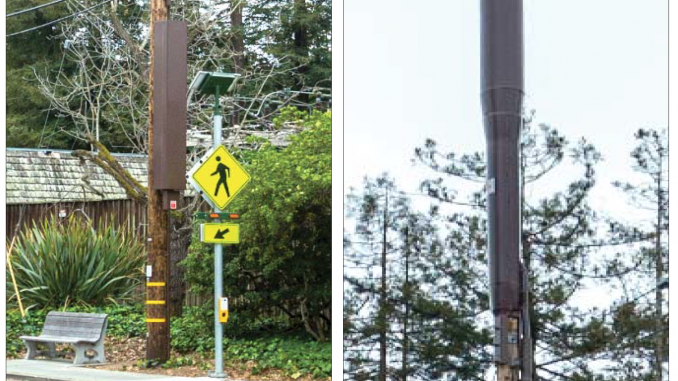
BY EMILY MIBACH
Daily Post Staff Writer
Los Altos became the first city in the mid-Peninsula to largely ban small cell antennas, or “nodes” in residential neighborhoods, but not all residents were behind the idea.
The council on Monday (Aug. 5) voted 4-0, with councilwoman Jeannie Bruins absent, to approve stringent regulations on the nodes after council members and residents expressed dismay over the aesthetics of the devices, along with the noises they make.
Cellphone companies say that the nodes, which are mounted to the top of utility poles, will improve service.
Resident Jim Fenton said that the city’s residents are not in unanimity on this topic. Fenton said he’s worried the ordinance will fly in the face of the FCC regulations and the city may get sued.
“I don’t want my tax dollars going to try to defend the city against something it will probably lose,” said Fenton.
Fenton and Verizon attorney Paul Albritton were the only two people to speak against the ordinance at Monday’s hearing. About 20 people went to the microphone, and the others were in favor of the ordinance.
Jeanine Valadez told the council that four of the proposed nodes would be near her Los Altos home.
“I don’t know why such proximity would be necessary,” Valadez said, adding that she is not happy with the humming noise the nodes make.
The ordinance sets forth the city’s preference order as to where these nodes can go. The lists puts neighborhoods at the bottom. The council also added in mixed-use buildings to the ordinance, they are not at the very bottom, but will require for cell phone companies to put the nodes a certain amount of feet away, so people in apartments or condos are not bothered.
This means the nodes aren’t completely banned in residential neighborhoods.
Assistant City Attorney Gail Karish warned the council that an outright ban could lead to lawsuits from cellphone companies.
FCC says cities can can’t stop telecoms from adding capacity to current nodes, installing 5G networks or improving service.
If telecom companies want to put a cell node in a neighborhood, they must file an application with the city that explains why the city must approve the project and how it will benefit the area’s cell coverage.
Applicants will also have to include the following:
• A description identifying where service will be improved if the node is installed in the neighborhood,
• A master plan of all proposed nodes in relation to the existing and potential locations in the city for nodes,
• An analysis of at least five other places in the area where the company could put the node instead,
• A sample of the proposed notice, and the envelope it will be mailed in, that will be sent to all residents within 1,000 feet of the new node.
The ordinance also requires that the nodes cannot be within 500 feet of a school, the nodes must be separated by 1,500 feet and be placed mid-block so they are not as obvious when placed on street corners.
